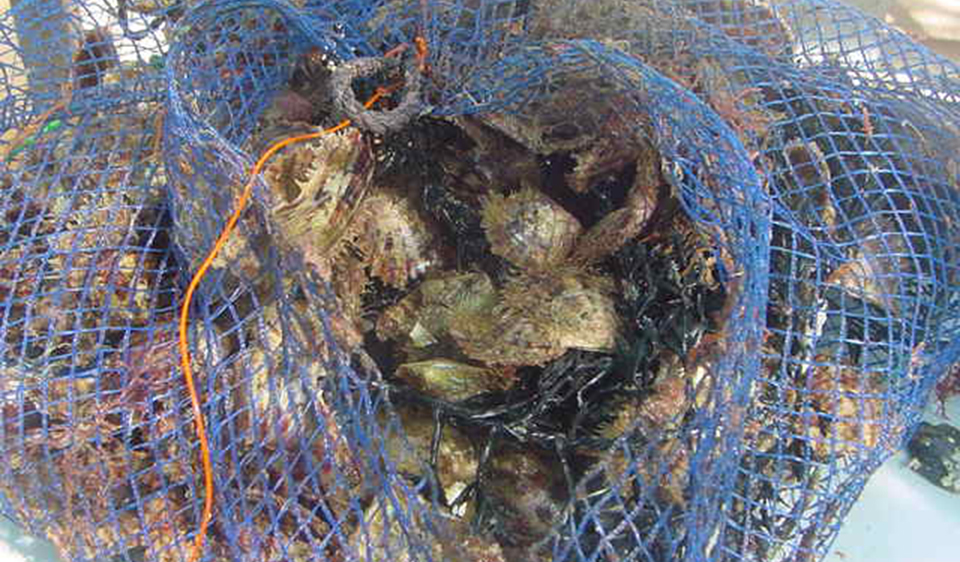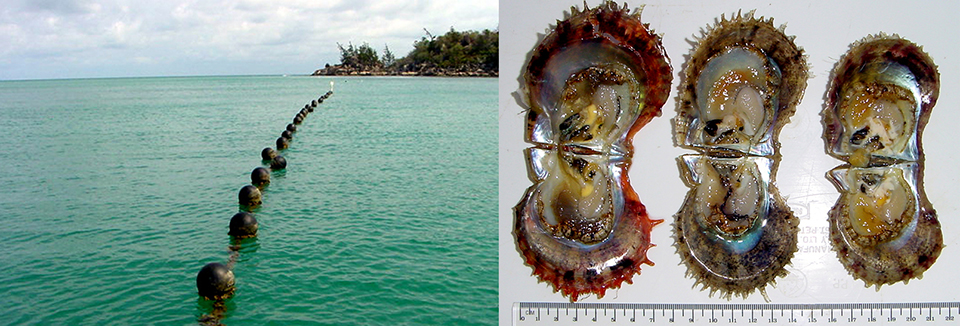Opportunity exists for other countries to meet any shortfalls in supply

Pearl culture, the largest aquaculture industry in Australia, is worth an estimated AUD 300 million (U.S. $197 million) annually. It is currently based on production from the silverlip pearl oyster (Pinctada maxima).
The culture of silver-lip pearl oysters began in earnest in Australia in the 1960s. Adult shells were collected from the wild and transported to pearl farms, where they were seeded to produce cultured pearls. However, overfishing and diseases almost crippled the industry in the 1980s.
Through improved management and the development of hatchery propagation techniques for larvae and spat (juvenile oysters), the pearl industry has once again begun to flourish. Today, Australia is world renowned for its lustrous South Sea pearls produced from P. maxima in northwestern Australia. There is also interest in pearl production from two additional species: the Akoya pearl oyster (P. fucata) and black-lip pearl oyster (P. margaritifera), which are both abundant in Australian waters.
Akoya pearl oysters
P. fucata have received increasing attention in Australia in the last few years following the decline of Akoya pearl production in Japan due to disease and pollution. For example, in 1996, the Akoya pearl oyster industry accounted for 66 percent of the total world pearl production, whereas in 2000, Akoya pearls only occupied 21 percent of the market. Consequently, the opportunity exists for other countries to meet any shortfalls in supply.
Akoya pearl oysters are currently cultured at research and/or commercial scales in Australia, the Caribbean, China, India and Japan. Research in Australia has included determining the feasibility of hatchery and early nursery culture of Akoya pearl oysters in tropical (Queensland) and subtropical (New South Wales) waters.
Queensland research
Research to date in Queensland has been carried out at James Cook University’s Orpheus Island Research Station. The techniques employed for P. fucata culture were adapted from those developed in this laboratory for P. margaritifera.
P. fucata broodstock are removed from the longline, scrubbed, and washed with 1-μ filtered seawater. Adult oysters are “cold conditioned” by placing them in a water bath at 220 degrees-C overnight. They are then placed in warm (30 degrees-C) water the following day, which induces spawning. Results have been promising, with P. fucata larvae competent to settle on day 20 with a mean (± S.E.) anterior-posterior measurement (APM) of 199 (± 5.4) μ.
Larvae are transferred into settlement tanks, where they remain until day 43. During hatchery production, larvae and spat are fed a microalgae diet consisting of Isochrysis galbana, Pavlova salina, and Chaetoceros muelleri at increasing densities of 1,000 cells per millileter on day 1 to 45,000 cells per milliliter on day 43.
On day 43, when the spat are transferred to the ocean, they have a mean dorso-ventral shell height (DVH) of 2.35 ± 0.9 mm. They are placed into 55- x 30- x 10-centimeter plastic mesh trays and positioned on a longline, where they remain until grading at 3.5 months of age. Graded oysters have a mean (± S.E.) DVH of 14.2 ± 1.3 mm with a range of 8.8 to 27.3 mm. Once graded, juvenile oysters are placed into pearl nets, where they reach a mean DVH of 44.09 ± 2.6 mm at 10 months of age.
A minimum dorso-ventral shell height of 50 mm is required for Akoya pearl production, indicating that hatchery-produced oysters could be seeded for pearl production at 12 to 14 months of age or less than a year after transfer from the hatchery. Oysters in Queensland have shown considerable growth, with shells capable of reaching 100 mm (in excess of 100 grams) in just over two years.
New South Wales

In New South Wales, experimental production of P. fucata is now in its fifth year. In more than 20 larval production runs, larval growth has varied significantly in both the time taken to reach pediveliger stage and the mean size of larvae at that stage.
Most commonly, larvae with a mean APM of 201 μ are placed in settlement tanks by day 20. Following metamorphosis, the spat are removed from the hatchery when they have grown to a minimum DVH of 1.5 mm – generally by day 50. Spat are thenplaced in 1-mm mesh bags and deployed on subsurface longlines. Subsequent growth is highly seasonal. Larval production is scheduled for late winter, and spat are deployed in spring.
In Port Stephens, which is in central New South Wales, spat deployed at this time are expected to grow at a rate of approximately 1 milliliters per week, although mean growth rates as high as 1.6 mm week have been recorded. At 10 mm, juveniles are placed in 6-mm mesh pearl cages. With 12 months further culture, oysters routinely reach a DVH of 50 to 55 mm and can be seeded.
Conclusion
In addition to filling a niche market with the small pearls that P. fucata typically produce, there are a number of other reasons to establish a P. fucata industry in Australia. P. fucata can be seeded at a small size – 50 mm, compared to 100 mm for P. margaritifera and 120 mm for P. maxima – which can be achieved in 12 to 18 months. Therefore, pearls grown from hatchery-produced P. fucata can be harvested in three years or less. Additionally, the shape of P. fucata allows two and sometimes three nuclei to be implanted in one oyster.
The results of projects in Queensland and New South Wales are encouraging and have provided a basis for the development of an Akoya pearl oyster industry in Australia. However, further work is required through optimizing pearl production as well as improving stocks through genetic selection and ploidy manipulation, which will help maintain Australia’s position as a leading pearl-producing nation.
(Editor’s Note: This article was originally published in the June 2003 print edition of the Global Aquaculture Advocate.)
Now that you've finished reading the article ...
… we hope you’ll consider supporting our mission to document the evolution of the global aquaculture industry and share our vast network of contributors’ expansive knowledge every week.
By becoming a Global Seafood Alliance member, you’re ensuring that all of the pre-competitive work we do through member benefits, resources and events can continue. Individual membership costs just $50 a year. GSA individual and corporate members receive complimentary access to a series of GOAL virtual events beginning in April. Join now.
Not a GSA member? Join us.
Authors
-
Josiah H. Pit, B.Sc.
Pearl Oyster Research Group
School of Marine Biology and Aquaculture
James Cook University
Townsville, Queensland 4811 Australia[117,97,46,117,100,101,46,117,99,106,64,116,105,112,46,104,97,105,115,111,106]
-
Wayne A. O’Connor, Ph.D.
New South Wales Fisheries
Port Stephens Fisheries Centre
Taylors Beach, New South Wales Australia
Tagged With
Related Posts

Health & Welfare
Alaska’s purple-hinge rock scallops considered for aquaculture development
Purple-hinge rock scallops are highly prized by local communities and harvested for subsistence in coastal Alaska. To evaluate the suitability of purple-hinge rock scallops for mariculture in Alaska, the authors conducted a four-year grow-out study.

Innovation & Investment
Aquaculture innovators come out of their shells at Fish 2.0
Biannual conference/competition showcased 40 new seafood businesses, or related services, from around the world. Winners were chosen on the strength of the opportunity, meaningful impact and compelling leadership and presentation.

Intelligence
Cooperation across seafood chain can counter mercury reports
Often-referenced but outdated reports have raised concerns over mercury, while in reality, not eating seafood carries greater risk than the minute presence of such chemicals. Cooperation and getting out consistently truthful, positive messages about seafood, the industry will see positive advances.

Intelligence
Hatching a plan for Florida oyster farming
Panacea Oyster Co-op and Pensacola Bay Oyster Co. each aim to open dedicated oyster hatcheries in Florida, which could have a significant impact on the state’s aquaculture industry.


